10 Tom Mikolyuk on Marianne Brandt
Besides being a sophomore Mechanical Engineering major at the University of Washington, Tom Mikolyuk is a brother, son, immigrant, athlete, plant dad, aspiring industrial design consultant, and above all, a maker. He makes multimedia, he makes physical objects, and he makes things happen.
Marianne Brandt (1893-1983) was a German multidisciplinary artist who, after training as a painter in Weimar in the 1910s, spent the mid-to-late 1920s as a designer, photographer, and the first female head of the metal workshop at the Bauhaus. Later, she did more industrial design and art education work, including for Bauhaus founder Walter Gropius’ architecture firm.
Unlike many of the other wonderful chapters in here, this one isn’t formatted as a letter. Do think of it as a script for a soon-to-be reflective video essay.
Chairs, teapots, and food containers are objects many of us 21st-century humans use every day. The other commonality between these objects is they were conceived and produced by industrial designers. When our interaction with those objects is seamless, we don’t notice their designs and what thought went into making those objects possible. However, interactions with things can be negative or cause negative outcomes in life, either by accident or intentionally from a designer’s work. Since designers hold such power over the way our material possessions are made and how they’re meant to be used, what is their role in creating a future that’s equitable and accessible to everyone? More generally: how do makers make a positive impact on society, especially with pressing social justice and climate issues facing a new generation of makers?
The modern design languages of the specific three objects in the previous paragraph, among others I didn’t mention, began at the Bauhaus. At the beginning of his manifesto for the Bauhaus, architect Walter Gropius, its founder, wrote that “the ultimate goal of all art is the building”[1]. On the surface level, the Bauhaus’s aim was to combine the ideas from visual arts and the practices of crafts to create the “building of the future”. On an overarching level, however, the Bauhaus aimed to “create a new guild of craftsmen, free of the divisive class pretensions that endeavoured to raise a prideful barrier between craftsmen and artists”[2] and redesign society at large[3], allowing the working class to access good design. Student-artists at the Bauhaus shaped their work based on forced connections[4] and a “synesthetic theory” of harmony between color, sound, and movement, as well as the three “fundamental shapes” of triangles, squares, and circles[5]. The Bauhaus also basically birthed the idea of “form follows function”[6], a phrase expressing the idea that the physical appearance of a design arises specifically from its intended uses and functions. Seeing that the Bauhaus has been so influential in industrial design in the last 100 years and that I want to pursue a career related to industrial product design, it seemed fitting to me to study a large contributor to the Bauhaus’s influence: Marianne Brandt. In this class, I explored the final question mentioned in the previous paragraph through the context of my own making projects and the legacy of Brandt’s work as a student at the Bauhaus.
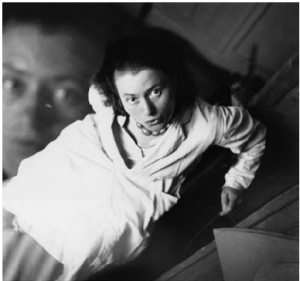
In the preliminary course at the Bauhaus, Josef Albers and Laszlo Moholy-Nagy suggested Brandt be the first woman to join the metalworking department instead of continuing to study painting, yet she was initially basically hazed by her male colleagues, who made her do “endless repetitive and mundane tasks.” Eventually, she became the head of the Bauhaus’s metal workshop and then left it in the summer of 1929 to work in industry, still expressing in letters to Walter Gropius that she was frustrated at “being hemmed in by the outdated taste of her bosses,” who were possibly male. Brandt’s possibly most famous work is her 1927 Tea Infuser, Model No. MT 49. The Infuser is composed entirely of the aforementioned fundamental shapes, with its main brass body shaped like a hemisphere with cylindrical surfaces stacked on top of each other, a semicircular heat resistant[7] ebony handle, and rectangular crossbar cradles on which the infuser rests[8]. It’s relatively small, however, at just three inches in height from the bottom of the cradle to the top of its cylindrical knob, which comes from the efficient use of space for the infusing function of the pot—an example of a harmonious interplay between form and function. In 1923, a year before Brandt made the Tea Infuser, the Bauhaus adopted the slogan “Art into Industry” which encapsulated a change in direction for the Bauhaus, “stressing the importance of designing for mass production”[9]. Theoretically, then, the fact that this craft-produced object is made from simple shapes makes it a good candidate for mass-production.
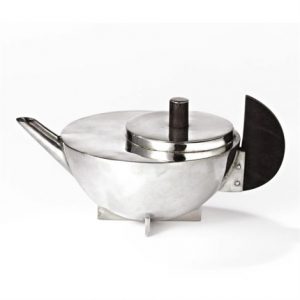
The most direct link I saw between the making process for the Tea Infuser and an assignment in class was in my Time Capsule: not only is most computer-aided design software made specifically to develop mass-producible models, but the logic in said software is just as geometric as the Tea Infuser and the Bauhaus’s design principles. To transform my Time Capsule from an idea to a physical 3D-printable model, the CAD software that I used, SolidWorks, required that I make extrusions and cuts to a material, each of which had to have a reference plane and reference dimensions. The geometry of each step of the modeling process ranged in complexity; the folds on the surface of the Time Capsule are triangles extruded around the curved edge of the surface using the Sweep function, while the bottom of the Time Capsule container is a polynomial curve which was used to cut out half of a parabolic cylinder shape. To me, the Time Capsule is an indicator that while technology has significantly altered what the act of making looks like, it hasn’t changed the logic or the intent of making much. In fact, the industrial-looking final product is reminiscent of the Bauhaus aesthetic of handmaking products to look like they’ve been industrially manufactured[10], even though there’s a 100+ year difference between the two objects.
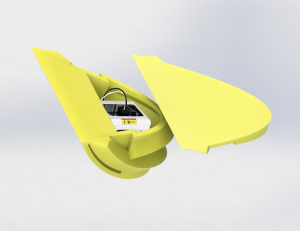
The Bauhaus sought to redefine the place of art and design in a turbulent, post-WWI German society by creating interdisciplinary work, and Brandt was a perfect example of an interdisciplinary maker. Before coming to the Bauhaus, she had studied multiple mediums of art, but this continued even after she became head of the Bauhaus’s metal workshop. Her other work at the Bauhaus included photomontages (like her self-portrait at the beginning of this page) and visual collages, some of which promoted her metal workshop and others that were purely artistic[11]. I considered myself an interdisciplinary person long before I entered the Interdisciplinary Honors program at UW, having dabbled in photography, video production, and graphic design before being exposed to industrial design in high school. I’ve paid much more attention to the interdisciplinary nature of my work now that I’m taking classes and participating in organizations at UW which contrast significantly from each other, though. At the same time that I’m cranking out problems on beam deformations in my engineering classes and developing manufacturing plans for an accessible toy for HuskyADAPT, I make graphic designs and layouts for The Daily. These activities each exercise different parts of my knowledge, yet they all involve designing creatively and all are contributing to my development as a maker, not just someone who can crunch numbers in the right ways. Making is an art, but it isn’t limited to art; in the same vein, engineering is a science, but it does not have to be limited to science.
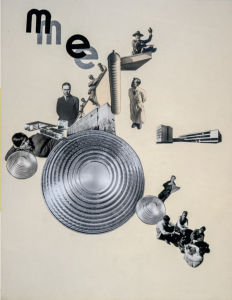
A traditionally stark difference between the concepts of making as engineering and making as art is in how large in scale the manufacturing of products that are results of a making process is. In my previous experience, art tended to be individually-produced in small quantities, while engineering referred to mass-production of standardized parts with very little deviation. Brandt’s Tea Infuser bridges the gap between a manufactured object and an artistic design; however, it wasn’t her only work that explored the relationship between mass-production and craft-production. Her aforementioned photomontages combined metallic surfaces, mirrors, and double-exposure techniques to “explore the relationship of the camera … to image creation”[12]. This is similar in nature to my work in this class, as I not only made an end product, but I also reveled in the experience of making and made conclusions about my relationship as a maker to said experience. On one hand, my Waiting Room project combined the industrial manufacturing technique of laser cutting with the essential craft that is sewing to create art that speaks about my literal and figurative place of mind. Just like Brandt moved between mediums multiple times in her life and symbiotically combined mediums in her work, I strengthened the meaning of sewed-together objects (a technique completely new to me this quarter) with familiar acrylic-cutting and gluing techniques to create my Waiting Room. Meanwhile, my Time Capsule is directly related to mass-manufacturing in everything but source; all of the individual components in my CAD model, as well as the time that it references (the scaling-up of 3D-printed face shield production at the UW), were solely the product of actions made by individual people, irreplicable by a computer. Therefore, in comparison to my previous examples of interdisciplinary work, my most direct connection to the interdisciplinary nature of art and design exists in this class. To successfully execute the ideas I had for art pieces, I had to not only understand how physical forms communicate ideas and feelings, but also the techniques of sewing, industrial machinery, and software that best fit the materials I wanted to construct my forms with. While technology has, again, significantly altered what the act of making looks like, it hasn’t changed the individualized, adaptive, and interdisciplinary nature of making.
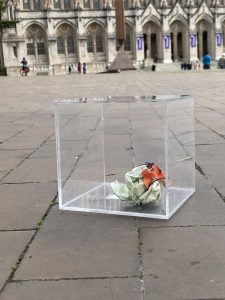
The individualized creation of the Tea Infuser and other Bauhaus prototypes isn’t without its detriments, though. Despite the Bauhaus’s aforementioned focus on designing for mass-production in the mid-1920s, the Tea Infuser design’s shape prevented it from being mass-produced, so it became a rare, luxurious item and it eventually sold in a 2007 Sotheby’s auction for $361,000[13]. My Time Capsule is, again, a great parallel to the Tea Infuser: even though it was designed to be mass-manufactured, it is a unique object in its intended use (besides the fact that I don’t have the money to 3D-print hundreds or thousands of copies of the Time Capsule). Furthermore, it could be considered a “socially engaged design”[14] since its form is a reference to how my engineering and design peers helped battle the COVID-19 pandemic in its early days, but its making and manufacturing processes aren’t accessible to everyone (especially considering the cost of 3D printing and acquiring CAD software). If objects like the Tea Infuser and my Time Capsule are meant to serve the masses, they fail at doing so by virtue of their individualized production; in the case of the Tea Infuser, it’s an ironic failure. In the words of scholars Denisa Kera and Joanne Pouzenc, the Tea Infuser “tries to reconcile the irreconcilable: the needs and desires for handmade and mechanical, luxury and mass-produced, disruptive and socially engaged design”[15].
I’ve found it difficult to reconcile the luxurious and inaccessible realities of craft with both my goals of reducing the material impact objects have on the environment and my career aspirations of working with mass-produced consumer tech products. While I align with Brandt and the Bauhaus in their goal of elevating the working class through industrial design, I do all of my making with a $2200 laptop on software that I either pay $30 a month for or that is provided by the university that I am privileged enough to be able to attend. Just like artistic designs that are meant to be commonplace can be co-opted by wealthy people as a tangible asset for storing wealth, my engineering and design work can be effectively co-opted by tech billionaires and leave me solely as a slave to profits if I’m not careful enough in my career. I can just as easily co-opt the struggles of those for whom I make and create an ineffective product. Ultimately, what good is my work—or any work, for that matter—if it only improves the quality of life for a few people, not everyone? Avoiding this requires empathy to be gained on the maker’s end—not only for the people for whom something is being made, but for all sociopolitical, economic, cultural, physical, and emotional contexts in which the end product is going to exist.
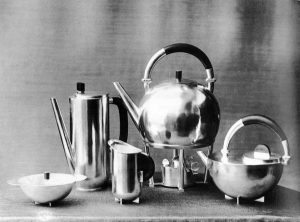
The sources I looked at in my research on Brandt’s work consider her Tea Infuser as an example of Gropius’s 1923 slogan of “Art and Technology: A New Unity,” similar to “Art into Industry,” but they were conflicted on whether it reflected on the motto positively or negatively. Art historians Elizabeth Otto and Patrick Rossler argue that Brandt’s metalwork “epitomizes” this slogan[16]. Meanwhile, Kera and Pouzenc argue that the Tea Infuser interprets the slogan “as a constant clash rather than unity of artistic (philosophical) experiments, industrial utility, and calls for social justice or revolution”[17]. Essentially, while the tea infuser was meant to aid the Bauhaus’s effort to “reform the working classes” through a luxurious experience of tea infusion, it actually reframed class differences in the lens of tea drinking. Kera and Pouzenc bring up “excesses of Silicon Valley prototypes and gadgets” as examples of class disparities reframed in mundane activities, including Juicero, the WiFi-connected juicer which was brought down completely by users discovering that they could press the juice out of the provided Juicero packets themselves.[18] Art and technology is an imperfect unity when it comes to craft since, as shown in the examples above, it too can be co-opted toward vapid use cases and away from meaning. The kind of careful thought that I put into materials and form choices for my Time Capsule and Waiting Room projects is similar to what makers who make an impact put into their work.
With that said, are the things that I made in this class worth any less because they aren’t functional in the traditional sense? Marianne Brandt made designs, but she also made art. In fact, her work at the Bauhaus is simultaneously design and art—it serves a purpose and communicates, in beautiful forms, to its viewers and users. It’s not like the turbulent context in which I live is unique, either, since the Bauhaus’s entire existence was contained within Germany’s first (albeit turbulent) democracy, while all of Europe tried to rebuild from a devastating war. The issues of self-expression, the fusion of art and craft, and the simplification/democratization of quality objects were as fundamental to Bauhaus makers as climate change and socioeconomic inequality are to me and my peers. There’s more to making than using skills to produce efficiently; my work in this class may be an example of the interdisciplinary nature of art and design, but because I’m so efficiency-oriented as a person and because the profession that I am graduating into is so efficiency-oriented, I often struggled with reflecting upon how it feels like to make and what my process and end product say about me and the context in which I live. My Waiting Room piece is just as important as my engineering drawings to the world, even though the latter is clearly functional and the former isn’t—my classmates related to the feelings of isolation, superposition, and being “stuck” in multiple ways that I expressed in Waiting Room. There are times where being an efficient maker is important, like when attempting to mass-3D-print face shields for healthcare workers, but those times aren’t “always.”
While some things about making are different between Marianne Brandt’s time and my time (especially in the technology both of us use(d) in our making processes), many crucial facets of being a maker have stayed the same. Makers who make an impact can, and should, make with practicality and a message in mind, not just functionality. They are adaptable, constantly learning, adjusting, and iterating on their own skills to create forms that have meaning. They also consider the impact of an object long after it’s created, even if they can’t control all parts of their receptions by the public. Furthermore, just like how the response to the issues of 1920s Germany and the creation of “building of the future” required interdisciplinary thinking and collaboration, the response to the issues of my time has already required collaboration between policy experts, climate scientists, engineers, activists, artists, and designers, some of whom fit multiple categories mentioned here. Makers who make an impact are interdisciplinary by necessity. These considerations are what make our interactions with designed objects and crafted art positive, and the world a better place to live.
Marianne Brandt was a maker who made an impact. I will, too.
Media Attributions
- Marianne-Brandt-Untitled-Self-Portrait-Double-Exposure-ca-1930-1931-modern © Marianne Brandt
- marianne-brandt-tea-infuser,-model-no.-mt-49
- TimeCapsuleCombine © Tom Mikolyuk
- me [“Metalwerkstatt”] © Marianne Brandt
- IMG_2316 © Tom Mikolyuk
- csm_Brandt_Marianne_Kaffee_und_Teeservice_1924_Foto_Lucia_Moholy_3f5f6071b6 © Lucia Moholy
- Gropius, Walter. “Program of the Staatliche Bauhaus in Weimar.” Design Museum of Chicago, 1919. https://bauhausmanifesto.com. ↵
- Gropius. ↵
- BBC Documentary - Bauhaus 100 - 100 Years of Bauhaus \ Walter Gropius. Brick Teasers, 2019. https://www.youtube.com/watch?v=2a45UBCIbJc. ↵
- Forlano, Laura, Molly Wright Steenson, and Mike Ananny, eds. “Prototypes, Products, and DIY Kits.” In Bauhaus Futures, 161–69. The MIT Press, 2019. https://doi.org/10.7551/mitpress/12044.003.0019. ↵
- BBC. ↵
- BBC. ↵
- Griffith Winton, Alexandra. “The Bauhaus, 1919–1933.” The Metropolitan Museum of Art, October 2016. https://www.metmuseum.org/toah/hd/bauh/hd_bauh.htm. ↵
- The Met. “Tea Infuser and Strainer,” 2021. https://www.metmuseum.org/art/collection/search/491299. ↵
- Griffith Winton. ↵
- BBC. ↵
- Otto, Elizabeth, and Patrick Rössler. “Marianne Brandt.” In Bauhaus Women: A Global Perspective, 80–85. London: Bloomsbury Publishing, 2019. ↵
- Otto, "Marianne Brandt." ↵
- Rawsthorn, Alice. “The Tale of a Teapot and Its Creator.” The New York Times. December 16, 2007. https://www.nytimes.com/2007/12/16/style/16iht-design17.1.8763227.html. ↵
- Forlano, “Prototypes, Products, and DIY Kits.” ↵
- Forlano, “Prototypes, Products, and DIY Kits.” ↵
- Otto, "Marianne Brandt." ↵
- Forlano, "Prototypes, Products, and DIY Kits." ↵
- Forlano, “Prototypes, Products, and DIY Kits.” ↵

